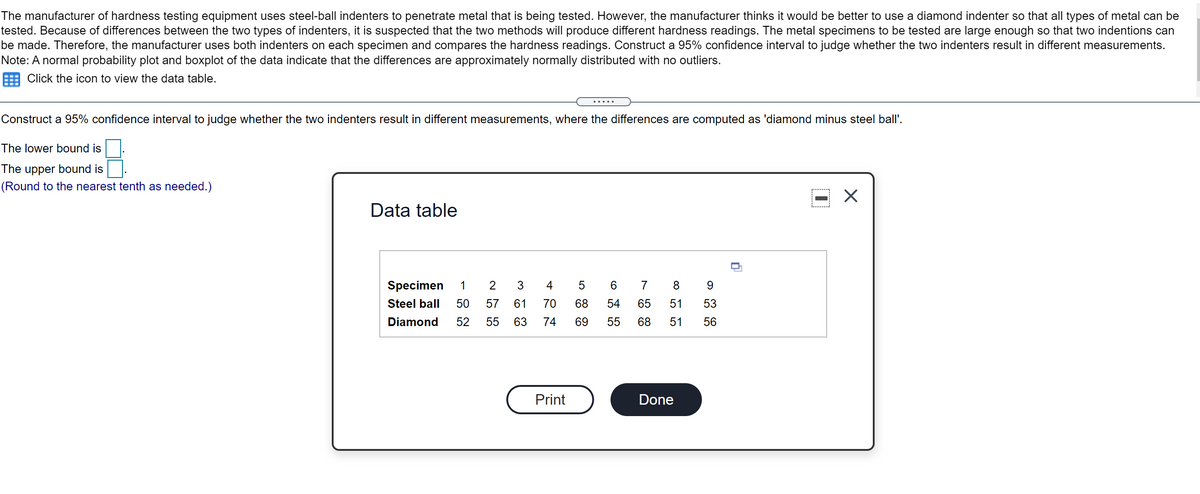The manufacturer of hardness testing equipment uses steel-ball indenters to penetrate metal that is being tested. However, the manufacturer thinks it would be better to use a diamond indenter so that all types of metal can be ested. Because of differences between the two types of indenters, it is suspected that the two methods will produce different hardness readings. The metal specimens to be tested are large enough so that two indentions can be made. Therefore, the manufacturer uses both indenters on each specimen and compares the hardness readings. Construct a 95% confidence interval to judge whether the two indenters result in different measurements. Note: A normal probability plot and boxplot of the data indicate that the differences are approximately normally distributed with no outliers. E Click the icon to view the data table. Construct a 95% confidence interval to judge whether the two indenters result in different measurements, where the differences are computed as 'diamond minus steel ball'. The lower bound is The upper bound is. (Round to the nearest tenth as needed.) Data table Specimen 1 3 4 7 8 9 Steel ball 50 57 61 70 68 54 65 51 53 Diamond 52 55 63 74 69 55 68 51 56
The manufacturer of hardness testing equipment uses steel-ball indenters to penetrate metal that is being tested. However, the manufacturer thinks it would be better to use a diamond indenter so that all types of metal can be ested. Because of differences between the two types of indenters, it is suspected that the two methods will produce different hardness readings. The metal specimens to be tested are large enough so that two indentions can be made. Therefore, the manufacturer uses both indenters on each specimen and compares the hardness readings. Construct a 95% confidence interval to judge whether the two indenters result in different measurements. Note: A normal probability plot and boxplot of the data indicate that the differences are approximately normally distributed with no outliers. E Click the icon to view the data table. Construct a 95% confidence interval to judge whether the two indenters result in different measurements, where the differences are computed as 'diamond minus steel ball'. The lower bound is The upper bound is. (Round to the nearest tenth as needed.) Data table Specimen 1 3 4 7 8 9 Steel ball 50 57 61 70 68 54 65 51 53 Diamond 52 55 63 74 69 55 68 51 56
MATLAB: An Introduction with Applications
6th Edition
ISBN:9781119256830
Author:Amos Gilat
Publisher:Amos Gilat
Chapter1: Starting With Matlab
Section: Chapter Questions
Problem 1P
Related questions
Question
Homework help

Transcribed Image Text:The manufacturer of hardness testing equipment uses steel-ball indenters to penetrate metal that is being tested. However, the manufacturer thinks it would be better to use a diamond indenter so that all types of metal can be
tested. Because of differences between the two types of indenters, it is suspected that the two methods will produce different hardness readings. The metal specimens to be tested are large enough so that two indentions can
be made. Therefore, the manufacturer uses both indenters on each specimen and compares the hardness readings. Construct a 95% confidence interval to judge whether the two indenters result in different measurements.
Note: A normal probability plot and boxplot of the data indicate that the differences are approximately normally distributed with no outliers.
Click the icon to view the data table.
.....
Construct a 95% confidence interval to judge whether the two indenters result in different measurements, where the differences are computed as 'diamond minus steel ball'.
The lower bound is
The upper bound is
(Round to the nearest tenth as needed.)
Data table
Specimen
1
2
4
7
8
9.
Steel ball
50
57
61
70
68
54
65
51
53
Diamond
52
55
63
74
69
55
68
51
56
Print
Dor
Expert Solution
This question has been solved!
Explore an expertly crafted, step-by-step solution for a thorough understanding of key concepts.
This is a popular solution!
Trending now
This is a popular solution!
Step by step
Solved in 2 steps with 3 images

Recommended textbooks for you

MATLAB: An Introduction with Applications
Statistics
ISBN:
9781119256830
Author:
Amos Gilat
Publisher:
John Wiley & Sons Inc

Probability and Statistics for Engineering and th…
Statistics
ISBN:
9781305251809
Author:
Jay L. Devore
Publisher:
Cengage Learning

Statistics for The Behavioral Sciences (MindTap C…
Statistics
ISBN:
9781305504912
Author:
Frederick J Gravetter, Larry B. Wallnau
Publisher:
Cengage Learning

MATLAB: An Introduction with Applications
Statistics
ISBN:
9781119256830
Author:
Amos Gilat
Publisher:
John Wiley & Sons Inc

Probability and Statistics for Engineering and th…
Statistics
ISBN:
9781305251809
Author:
Jay L. Devore
Publisher:
Cengage Learning

Statistics for The Behavioral Sciences (MindTap C…
Statistics
ISBN:
9781305504912
Author:
Frederick J Gravetter, Larry B. Wallnau
Publisher:
Cengage Learning

Elementary Statistics: Picturing the World (7th E…
Statistics
ISBN:
9780134683416
Author:
Ron Larson, Betsy Farber
Publisher:
PEARSON

The Basic Practice of Statistics
Statistics
ISBN:
9781319042578
Author:
David S. Moore, William I. Notz, Michael A. Fligner
Publisher:
W. H. Freeman

Introduction to the Practice of Statistics
Statistics
ISBN:
9781319013387
Author:
David S. Moore, George P. McCabe, Bruce A. Craig
Publisher:
W. H. Freeman